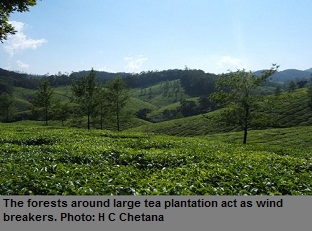Any and all opinions expressed in this newsletter are solely those of the author(s) and do not reflect the opinion of ATREE.
Centre for Excellence in Conservation Science
Royal Enclave,Srirampura,Jakkur Post
Bangalore-560064
Telephone: 080-23635555 (EPABX)
Fax : 080- 23530070
One cannot miss the tea plantations which appear most like 'emerald islands' studded amidst rainforest in Western Ghats. They are unique and structurally different from coffee, cardamom and rubber plantations. The monotony of large tea plantations is broken occasional by forest corridors which act as wind breakers. These patches are also critical for many wild animal species which use them to move between forest patches. In recent times the dip in the demand for the Indian tea in the international market has led to abandoning of a huge number of estates. What are the ecological consequences of these abandoned plantations? Can we restore them for posterity and increase the forest cover of Western Ghats? These questions drew me to examine ecological, economic and legal issues centering around plantations. For forest to recover, corridors can be an important source for seeds of native tree species. I hypothesized that distance of the plantation from the forest corridors is an important factor for seed dispersal by non- volant (non-flying) mammals. So I went about estimating the number of seeds that arrive at two distances from the corridor, one tea plantation closer to the corridors (< 50 m ) and second further (>50m) away from the corridors. We laid 120 transects within the plantations at the two distances and recorded seeds arriving through frugivore droppings over a year.
A total of 2518 seeds were counted that belonged to 13 species within 120 transects (1 by100 m). All the 13 species (1877 seeds) were recorded within < 50 m from the forest corridor, whereas > 50 m away only 6 species (641 seeds) were recorded. The results support the hypothesis that distance from forest corridor is important in terms of both species and number of seeds dispersed by non-volant seed frugivores. Most of the seeds were brought to the tea plantation by the brown palm civet (Paradoxurus jerdoni), which is a nocturnal frugivore and prefers forest canopies.
It however comes to the ground often to defecate on logs and along trails. It seldom moves into the open and this explains why the seeds found in the plantations are close to the forest. Only occasionally does it venture far from the corridor edge. This behavior could explain the seed deposition patterns in the tea plantations. However, the shade trees in - midst of the plantations, draws avian seeddispersers and this contributes to seed deposition more in open areas. However, composition of seeds by the two modes vary drastically. We therefore need a combination of strategies for natural restoration of abandoned plantations. Implementing this, is however subject to solving the legal and socioeconomic problems associated with abandonment.
Editorial Team
Editor: Allwin Jesudasan
Associate editor: Rajkamal Goswami
Editorial Review: R. Ganesan, M. Soubadra Devy, T. Ganesh
Design and presentation: Kiran Salagame
A S H O K A T R U S T F O R R E S E A R C H I N E C O L O G Y A N D T H E E
N V I R O N M E N T
Research Highlights:
Importance of corridors and its ecological services
- H C Chetana
If you have any suggestions or comments please let us know through the boxes below






